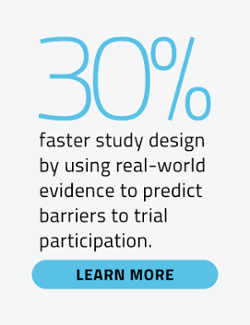Putting Data to Work: How RWE Can Deliver Speed, Insights, and Value for Clinical Trials

Real-world evidence and synthetic control arms based on rich, patient-level data can make clinical trials faster, less expensive, and more representative.
It’s time to reboot clinical trial design. The boom in real-world data and the growing sophistication of analytical approaches are sparking growth in the use of real-world evidence (RWE) to inform trial design and evidence generation plans. In tandem, we’re seeing the possibility of synthetic control arms, in which existing patient-level health data is used to supplement or replace the evidence traditionally generated from clinical trial control groups. And regulatory agencies are increasingly on board. The FDA recently approved use of a hybrid external control, combining synthetic controls and randomized patients. Medicenna’s approval for MDNA55 is an example of a therapy that was supported with real-world evidence.
By putting existing data to work, RWE can inform trial design in a way that saves time and money and better represents patients, speeding the delivery of new therapies to those who need them.

Time Matters
Clinical development is a rigorous process, with phase 3 trials consuming up to three years and enrolling thousands of patients. Patient recruitment often dictates the pace at which a trial proceeds: up to 90% of clinical trials are unable to enroll patients within their target timeframe — and some even prematurely terminated — by low enrollment. Using RWE to analyze different patient journeys and natural histories can help better identify patient populations with the greatest opportunity to benefit. A better informed trial design that capitalizes on the value of RWE — such as potential synthetic control arms — could mean fewer patients need to be recruited. Fewer patients means faster progress and less risk of failure, which could be particularly valuable in trials for rare diseases where there aren’t many eligible patients or for medicines treating end-stage unmet needs. In the case of a synthetic control arm, it also means more participants receive the therapy being tested rather than the standard of care or a placebo – a huge plus for patients who may be in dire need of alternatives.
Time Is Money
The high costs of clinical development may prevent promising therapies from ever reaching patients. The longer a trial lasts, the more it costs. With an average per-patient cost of more than $41,000 for phase 3 trials, RWE can also decrease costs by designing trials that cut down on study-related visits, supplies, equipment, and clinical procedures. This is particularly true for trials where the control arm involves an expensive comparator drug, the control treatment arm can be the largest single cost component. All of these efforts help to ensure new treatments make it to market faster, and into the hands of the patients who need it the most.
Improve Representation
To obtain reliable information on the effects of a potential therapy, clinical trials apply strict eligibility criteria for participants, which may result in the unwanted effect of limiting their applicability in the real world. RWE can inform trial design and execution to include more diverse patients, better reflecting the complete patient population. RWE can also identify patient groups most likely to benefit from new therapies and proactively enable the trial design and execution to include participants that represent those groups.
Studies that leverage insights based on historical data, sources such as EHRs, claims data or patient-generated data offer significant improvements to the current clinical trials process. While still early in the exploration of synthetic control arms, RWE is here now and can help make clinical trials that deliver results faster, cost less, and better represent real-world populations — ultimately improving outcomes for patients. But it’s critical that the RWE used to inform these decisions is a complete view of the patients, and their experiences, throughout the healthcare system. At Komodo, we’ve built the world’s most comprehensive view of patient lives to deliver the most accurate and up-to-date data on patient encounters within the healthcare system. Paired with our innovative algorithms and decades of clinical expertise, our solutions can help to optimize clinical trial design, delivering more powerful treatments to more patients and reducing the burden of disease.
Learn more about how Komodo Health is  .
.
To see more articles like this, follow Komodo Health on Twitter and LinkedIn, and visit Insights on our website.






